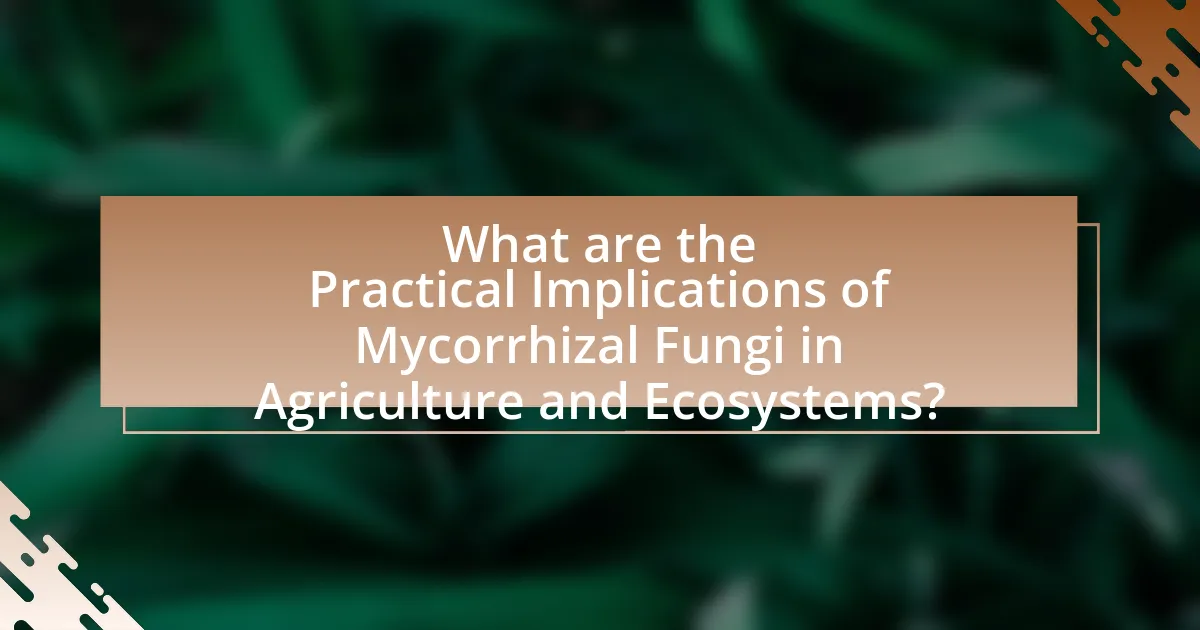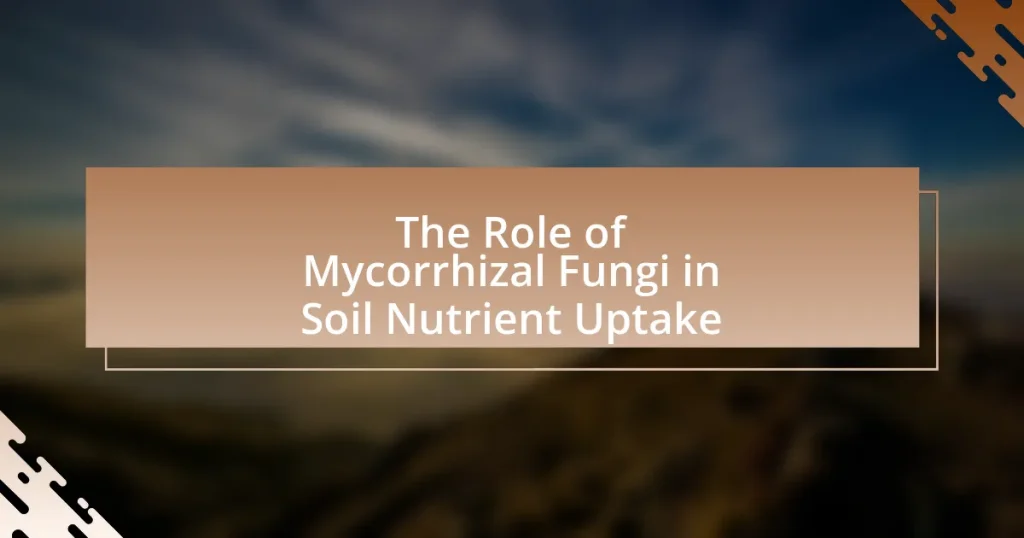Mycorrhizal fungi are symbiotic organisms that enhance soil nutrient uptake by forming associations with plant roots, significantly improving the absorption of essential nutrients such as phosphorus and nitrogen. These fungi extend their hyphae into the soil, increasing the surface area for nutrient absorption and facilitating nutrient transfer to plants. The article explores the types of mycorrhizal associations, their role in soil health and structure, and the factors influencing their effectiveness in different soil environments. Additionally, it discusses the practical implications of mycorrhizal fungi in agriculture, including best practices for enhancing their populations and the challenges they face in modern ecosystems.

What are Mycorrhizal Fungi and Their Role in Soil Nutrient Uptake?
Mycorrhizal fungi are symbiotic organisms that form associations with plant roots, enhancing nutrient uptake, particularly phosphorus, nitrogen, and micronutrients. These fungi extend their hyphae into the soil, increasing the surface area for absorption and facilitating the transfer of nutrients to the plant. Research indicates that mycorrhizal associations can improve plant growth and resilience, with studies showing that plants with mycorrhizal fungi can absorb up to 90% more phosphorus compared to non-mycorrhizal plants. This symbiotic relationship is crucial for soil health and ecosystem functioning, as it promotes nutrient cycling and enhances soil structure.
How do Mycorrhizal Fungi interact with plant roots?
Mycorrhizal fungi form symbiotic relationships with plant roots, enhancing nutrient uptake for the plants. These fungi colonize the root system, extending their hyphae into the soil, which increases the surface area for absorption of water and essential nutrients like phosphorus and nitrogen. Research indicates that plants with mycorrhizal associations can access up to 90% more phosphorus compared to non-mycorrhizal plants, demonstrating the significant role these fungi play in nutrient acquisition. This interaction not only benefits the plants by improving their growth and health but also supports soil structure and fertility.
What types of mycorrhizal associations exist?
Two main types of mycorrhizal associations exist: arbuscular mycorrhizae and ectomycorrhizae. Arbuscular mycorrhizae, formed primarily by fungi from the Glomeromycota phylum, penetrate the root cells of plants, facilitating nutrient exchange, particularly phosphorus. Ectomycorrhizae, on the other hand, are formed by fungi from various phyla, including Basidiomycota and Ascomycota, and create a sheath around the roots without penetrating the cells, enhancing nutrient uptake, especially nitrogen and water. These associations are crucial for plant health and soil nutrient dynamics, as they significantly increase the surface area for absorption and improve plant resistance to pathogens.
How do these associations enhance nutrient absorption?
Mycorrhizal fungi enhance nutrient absorption by forming symbiotic relationships with plant roots, which increases the surface area for nutrient uptake. This association allows plants to access nutrients such as phosphorus and nitrogen more efficiently than they could alone. Research indicates that mycorrhizal networks can improve nutrient exchange by up to 90%, facilitating the transfer of essential minerals from the soil to the plant. Additionally, these fungi secrete enzymes that break down organic matter, further increasing nutrient availability.
Why are Mycorrhizal Fungi important for soil health?
Mycorrhizal fungi are crucial for soil health because they enhance nutrient uptake for plants, particularly phosphorus, which is often limited in soils. These fungi form symbiotic relationships with plant roots, extending their hyphae into the soil, which increases the surface area for absorption. Research indicates that mycorrhizal associations can improve plant growth and soil structure, leading to increased organic matter and microbial diversity. Studies show that plants with mycorrhizal fungi can absorb up to 90% more phosphorus compared to those without, demonstrating their significant role in nutrient cycling and overall soil fertility.
What role do they play in soil structure and stability?
Mycorrhizal fungi play a crucial role in enhancing soil structure and stability by forming symbiotic relationships with plant roots. These fungi create a network of hyphae that binds soil particles together, improving soil aggregation and reducing erosion. Research indicates that mycorrhizal associations can increase soil porosity and water retention, which contributes to overall soil health and stability. Additionally, studies have shown that soils with active mycorrhizal populations exhibit greater resilience to disturbances, further supporting their role in maintaining soil structure.
How do they contribute to soil biodiversity?
Mycorrhizal fungi contribute to soil biodiversity by forming symbiotic relationships with plant roots, enhancing nutrient uptake and promoting a diverse microbial community. These fungi increase the surface area for absorption, allowing plants to access nutrients like phosphorus and nitrogen more efficiently, which in turn supports a wider variety of plant species. Research indicates that mycorrhizal networks facilitate the exchange of nutrients and information between plants, fostering a more complex ecosystem. For example, a study published in “Nature” by van der Heijden et al. (1998) demonstrated that mycorrhizal associations significantly increase plant diversity in grasslands, highlighting their crucial role in maintaining soil biodiversity.
What nutrients do Mycorrhizal Fungi help plants absorb?
Mycorrhizal fungi help plants absorb essential nutrients such as phosphorus, nitrogen, potassium, and micronutrients like zinc and copper. These fungi form symbiotic relationships with plant roots, enhancing nutrient uptake by increasing the surface area for absorption and facilitating the transfer of nutrients from the soil to the plant. Research indicates that mycorrhizal associations can increase phosphorus uptake by up to 90%, significantly benefiting plant growth and health.
How do they facilitate phosphorus uptake?
Mycorrhizal fungi facilitate phosphorus uptake by forming symbiotic relationships with plant roots, enhancing the plant’s access to phosphorus in the soil. These fungi extend their hyphae into the soil, increasing the surface area for absorption and effectively accessing phosphorus that is otherwise unavailable to plants due to its low mobility in the soil. Research has shown that mycorrhizal associations can increase phosphorus uptake by up to 90%, significantly improving plant growth and nutrient status.
What is their role in nitrogen and micronutrient absorption?
Mycorrhizal fungi play a crucial role in nitrogen and micronutrient absorption by forming symbiotic relationships with plant roots, enhancing nutrient uptake. These fungi extend their hyphal networks into the soil, increasing the surface area for absorption and facilitating the transfer of nitrogen and essential micronutrients, such as zinc and copper, to the host plant. Research indicates that mycorrhizal associations can improve nitrogen availability by enhancing the decomposition of organic matter and increasing the efficiency of nitrogen-fixing bacteria in the soil. Studies have shown that plants associated with mycorrhizal fungi can absorb up to 90% more nitrogen compared to non-mycorrhizal plants, demonstrating their significant impact on nutrient acquisition.

How do Mycorrhizal Fungi Adapt to Different Soil Environments?
Mycorrhizal fungi adapt to different soil environments by altering their hyphal structures and metabolic processes to optimize nutrient acquisition. In nutrient-poor soils, these fungi develop extensive hyphal networks that increase surface area for absorption, allowing them to efficiently extract phosphorus and other essential nutrients. Additionally, mycorrhizal fungi can modify their enzymatic activity to break down organic matter and release nutrients in response to soil conditions. Research has shown that different species of mycorrhizal fungi exhibit varying degrees of adaptability, with some being more effective in arid or acidic soils, thereby enhancing plant growth and soil health in diverse environments.
What factors influence the effectiveness of Mycorrhizal Fungi in nutrient uptake?
The effectiveness of Mycorrhizal Fungi in nutrient uptake is influenced by several key factors, including soil type, plant species, environmental conditions, and the specific type of mycorrhizal fungi involved. Soil type affects the availability of nutrients and moisture, which can enhance or limit fungal activity. Different plant species form symbiotic relationships with specific mycorrhizal fungi, impacting nutrient exchange efficiency. Environmental conditions such as temperature, pH, and moisture levels also play a critical role in fungal growth and function. Additionally, the type of mycorrhizal fungi, whether arbuscular or ectomycorrhizal, determines the range of nutrients that can be effectively absorbed, as each type has distinct mechanisms for nutrient acquisition. These factors collectively determine the overall effectiveness of Mycorrhizal Fungi in enhancing nutrient uptake for plants.
How does soil pH affect Mycorrhizal activity?
Soil pH significantly affects Mycorrhizal activity by influencing the availability of nutrients and the overall health of the fungal symbionts. Mycorrhizal fungi thrive in a pH range of approximately 5.5 to 7.5, where nutrient availability, particularly phosphorus, is optimal. Outside this range, especially in highly acidic or alkaline soils, the activity and colonization rates of Mycorrhizal fungi decline, leading to reduced nutrient uptake for plants. Research indicates that at low pH levels, aluminum toxicity can inhibit fungal growth, while high pH can lead to nutrient lock-up, both of which negatively impact Mycorrhizal function (Hodge & Campbell, 2009, “Mycorrhizal Fungi and Soil Nutrient Uptake,” Soil Biology and Biochemistry).
What impact do soil moisture levels have on their function?
Soil moisture levels significantly influence the function of mycorrhizal fungi in nutrient uptake. Adequate moisture enhances the fungi’s ability to extend their hyphal networks, which increases the surface area for nutrient absorption, particularly phosphorus and nitrogen. Research indicates that optimal soil moisture conditions can improve the symbiotic relationship between plants and mycorrhizal fungi, leading to enhanced plant growth and nutrient acquisition. For instance, a study published in “Soil Biology and Biochemistry” by Smith and Read (2008) demonstrates that mycorrhizal fungi are more effective in nutrient uptake under moderate moisture conditions, as excessive dryness or saturation can hinder their activity and reduce nutrient availability.
How do land management practices affect Mycorrhizal Fungi?
Land management practices significantly influence Mycorrhizal fungi by altering soil structure, nutrient availability, and microbial diversity. Practices such as tillage can disrupt fungal networks and reduce their populations, while organic farming methods that enhance soil health promote Mycorrhizal colonization. Research indicates that reduced tillage increases Mycorrhizal abundance, as shown in a study by Rillig et al. (2015), which found that conservation tillage practices led to higher fungal biomass and diversity compared to conventional tillage. Additionally, the application of organic amendments, such as compost, has been shown to enhance Mycorrhizal activity by improving soil nutrient content and fostering a conducive environment for fungal growth.
What practices promote healthy Mycorrhizal populations?
Practices that promote healthy Mycorrhizal populations include maintaining soil health through organic matter addition, minimizing soil disturbance, and promoting plant diversity. Organic matter, such as compost or mulch, enhances soil structure and provides nutrients that support Mycorrhizal fungi. Minimizing soil disturbance, particularly through reduced tillage, preserves the fungal networks and their habitat. Additionally, planting a diverse range of species encourages a variety of Mycorrhizal associations, which can improve overall soil nutrient uptake and ecosystem resilience. Research indicates that these practices lead to increased Mycorrhizal colonization rates and improved plant health, demonstrating their effectiveness in fostering robust Mycorrhizal populations.
How can agricultural practices hinder their effectiveness?
Agricultural practices can hinder their effectiveness by disrupting the symbiotic relationships between plants and mycorrhizal fungi. These fungi enhance nutrient uptake, particularly phosphorus, but practices such as excessive tillage, monocropping, and the use of chemical fertilizers can damage fungal networks. For instance, studies show that tillage can reduce mycorrhizal colonization by up to 50%, leading to decreased soil fertility and plant health. Additionally, monocropping limits the diversity of plant species, which can negatively impact the diversity and function of mycorrhizal communities, further reducing nutrient availability.

What are the Practical Implications of Mycorrhizal Fungi in Agriculture and Ecosystems?
Mycorrhizal fungi significantly enhance agricultural productivity and ecosystem health by improving soil nutrient uptake and plant growth. These fungi form symbiotic relationships with plant roots, facilitating the absorption of essential nutrients such as phosphorus and nitrogen, which are often limited in soil. Research indicates that crops associated with mycorrhizal fungi can exhibit increased yields, with studies showing up to a 30% improvement in crop productivity due to enhanced nutrient availability. Additionally, mycorrhizal fungi contribute to soil structure and stability, promoting water retention and reducing erosion, which further supports ecosystem resilience. Their role in nutrient cycling and soil health underscores their practical implications in sustainable agriculture and ecosystem management.
How can farmers utilize Mycorrhizal Fungi for better crop yields?
Farmers can utilize Mycorrhizal Fungi to enhance crop yields by improving nutrient uptake, particularly phosphorus and micronutrients. These fungi form symbiotic relationships with plant roots, increasing the surface area for absorption and facilitating access to nutrients that are otherwise unavailable to plants. Research indicates that crops associated with Mycorrhizal Fungi can exhibit yield increases of 20% to 50%, as these fungi enhance soil structure and moisture retention, leading to healthier plants. Studies, such as those published in the journal “Soil Biology and Biochemistry,” demonstrate that Mycorrhizal associations significantly boost plant growth and resilience, confirming their critical role in sustainable agriculture.
What are the best practices for inoculating crops with Mycorrhizal Fungi?
The best practices for inoculating crops with Mycorrhizal Fungi include selecting the appropriate fungal species, applying the inoculum at the right time, ensuring proper soil conditions, and using compatible crop varieties. Selecting the right species, such as Glomus spp., is crucial as different fungi have varying benefits for specific crops. Timing the application during planting or early growth stages enhances colonization efficiency. Maintaining optimal soil conditions, including pH and moisture levels, supports fungal growth and activity. Additionally, using crop varieties that are known to form beneficial relationships with mycorrhizal fungi can maximize nutrient uptake and overall plant health. Research indicates that these practices significantly improve crop yield and nutrient absorption, demonstrating the effectiveness of mycorrhizal inoculation in agricultural systems.
How can Mycorrhizal Fungi contribute to sustainable farming practices?
Mycorrhizal fungi contribute to sustainable farming practices by enhancing soil nutrient uptake and improving plant health. These fungi form symbiotic relationships with plant roots, increasing the surface area for absorption of essential nutrients such as phosphorus and nitrogen. Research indicates that crops associated with mycorrhizal fungi can exhibit up to a 50% increase in nutrient uptake compared to non-mycorrhizal plants. This increased efficiency reduces the need for chemical fertilizers, promoting environmentally friendly farming practices. Additionally, mycorrhizal fungi improve soil structure and water retention, further supporting sustainable agriculture by enhancing resilience to drought and reducing erosion.
What challenges do Mycorrhizal Fungi face in modern ecosystems?
Mycorrhizal fungi face significant challenges in modern ecosystems, primarily due to habitat destruction, climate change, and agricultural practices. Habitat destruction reduces the diversity and availability of plant hosts, which are essential for mycorrhizal symbiosis. Climate change alters soil temperatures and moisture levels, impacting fungal growth and function. Additionally, intensive agricultural practices, such as the use of chemical fertilizers and pesticides, disrupt the natural soil microbiome, negatively affecting mycorrhizal networks. Studies indicate that these factors collectively threaten the ecological roles of mycorrhizal fungi in nutrient uptake and soil health, as they rely on stable environments and diverse plant communities to thrive.
How do environmental changes impact their populations?
Environmental changes significantly impact the populations of mycorrhizal fungi by altering their habitat, nutrient availability, and symbiotic relationships with plants. For instance, increased temperatures and altered precipitation patterns can lead to changes in soil moisture and nutrient dynamics, which directly affect fungal growth and reproduction. Research indicates that shifts in land use and climate can reduce the diversity and abundance of mycorrhizal fungi, as seen in studies where drought conditions led to a decline in fungal populations and their associated plant partners. This decline can disrupt nutrient uptake in plants, as mycorrhizal fungi play a crucial role in enhancing phosphorus and nitrogen availability in the soil.
What are the consequences of declining Mycorrhizal Fungi for soil health?
The decline of Mycorrhizal Fungi leads to significant negative consequences for soil health, including reduced nutrient availability and impaired soil structure. Mycorrhizal fungi form symbiotic relationships with plant roots, enhancing the uptake of essential nutrients such as phosphorus and nitrogen. When these fungi decline, plants experience nutrient deficiencies, which can result in stunted growth and decreased crop yields. Additionally, the absence of mycorrhizal networks disrupts soil aggregation, leading to increased erosion and decreased water retention. Research indicates that soils with healthy mycorrhizal populations exhibit improved fertility and resilience, underscoring the critical role these fungi play in maintaining soil health.
What are the best practices for enhancing Mycorrhizal Fungi in soil?
To enhance Mycorrhizal Fungi in soil, implement practices such as reducing soil disturbance, incorporating organic matter, and using cover crops. Reducing soil disturbance preserves the fungal networks, as excessive tilling can disrupt their growth. Incorporating organic matter, like compost or mulch, provides essential nutrients and a conducive environment for fungi. Utilizing cover crops, such as clover or vetch, promotes fungal diversity and enhances soil health by improving organic matter content and soil structure. Research indicates that these practices significantly increase mycorrhizal colonization rates, leading to improved nutrient uptake and overall soil fertility.










